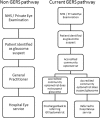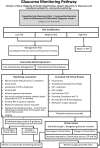Care pathways for glaucoma detection and monitoring in the UK
- PMID: 31700149
- PMCID: PMC7002668
- DOI: 10.1038/s41433-019-0667-9
Care pathways for glaucoma detection and monitoring in the UK
Abstract
Glaucoma presents considerable challenges in providing clinically and cost-effective care pathways. While UK population screening is not seen as justifiable, arrangements for case finding have historically been considered relatively ineffective. Detection challenges include an undetected disease burden, whether from populations failing to access services or difficulties in delivering effective case-finding strategies, and a high false positive rate from referrals via traditional case finding pathways. The enhanced General Ophthalmic Service (GOS) in Scotland and locally commissioned glaucoma referral filtering services (GRFS) elsewhere have undoubtedly reduced false positive referrals, and there is emerging evidence of effectiveness of these pathways. At the same time, it is recognised that implementing GRFS does not intrinsically reduce the burden of undetected glaucoma and late presentation, and obvious challenges remain. In terms of diagnosis and monitoring, considerable growth in capacity remains essential, and non-medical health care professional (HCP) co-management and virtual clinics continue to be important solutions in offering requisite capacity. National guidelines, commissioning recommendations, and the Common Clinical Competency Framework have clarified requirements for such services, including recommendations on training and accreditation of HCPs. At the same time, the nature of consultant-delivered care and expectations on the glaucoma specialist's role has evolved alongside these developments. Despite progress in recent decades, given projected capacity requirements, further care pathways innovations appear mandated. While the timeline for implementing potential artificial intelligence innovations in streamlining care pathways is far from established, the glaucoma burden presents an expectation that such developments will need to be at the vanguard of future developments.
摘要: 青光眼在提供临床和成本效益的护理途径方面面临着相当大的挑战。虽然英国的人群筛查被认为是不合理的, 但在历史上, 个体诊断也一直认为是相对无效的。早期诊断方面的挑战包括了未被发现的疾病负担, 无论是无法获得服务的人群筛查还是难以提供有效的病例发现策略, 以及通过传统的转诊途径所发现的病例诊断的高假阳性率。不断提升的苏格兰普通眼科服务 (GOS) 和其他地方委托的青光眼转诊过滤服务 (GRFS) 无疑减少了假阳性转诊率, 而且新的证据表明这些途径是有效的。同时, 我们认识到实施GRFS并不能从本质上减轻未被发现的青光眼和晚期青光眼的负担, 而且仍存在明显的挑战。在早期诊断和监测方面, 监护能力的大幅增长仍至关重要, 非医疗保健专业人员 (HCP) 联合管理和虚拟诊所仍然是提供必要能力的重要解决办法。国家指导方针、委托建议和共同临床能力框架阐明了对此类服务的要求, 包括对HCP培训和认证的建议。同时, 在青光眼专家在咨询以及对其期待的承担的角色也伴随着这些发展而变化。尽管近几十年来取得了进展, 但考虑到预期的能力需求, 进一步的护理路径创新似乎已迫在眉睫。虽然在简化青光眼的护理路径方面实施潜在的人工智能创新的时间还远未确定, 但对青光眼早期诊断与监控的巨大负担也预示着它将成为未来发展的先锋.
Conflict of interest statement
The authors declare that they have no conflict of interest.
Figures




Comment in
-
Patient satisfaction with the virtual glaucoma clinic.Eye (Lond). 2021 Mar;35(3):1017-1018. doi: 10.1038/s41433-020-0946-5. Epub 2020 May 12. Eye (Lond). 2021. PMID: 32398844 Free PMC article. No abstract available.
References
-
- The Royal College of Ophthalmologists. The Way Forward: Options to help meet demand for the current and future care of patients with eye disease: Glaucoma. The Royal College of Ophthalmologists, London, January 2017.
-
- Rutherford T. Population ageing: statistics. https://www.parliamentuk/briefing-papers/sn03228pdf 2012; SN/SG/3228.
-
- Baker H, Ratnarajan G, Harper RA, Edgar DF, Lawrenson JG. The effectiveness of enhanced optometric services in the management of acute and chronic ophthalmic disease: a realist review of the literature. Ophthalmic Physiol Opt. 2016;36:545–57.. - PubMed
Publication types
MeSH terms
LinkOut - more resources
Full Text Sources
Medical
Miscellaneous

